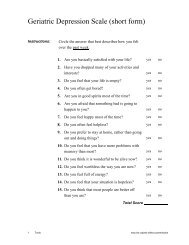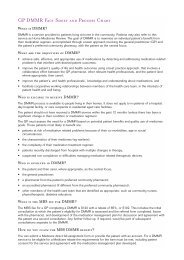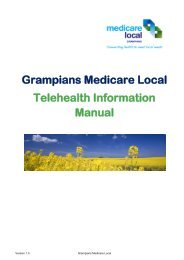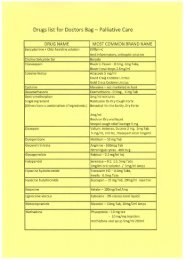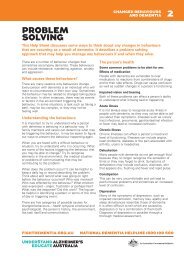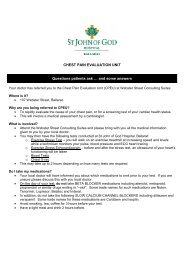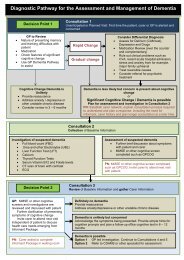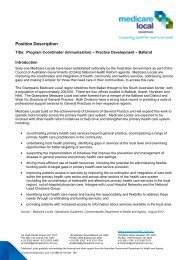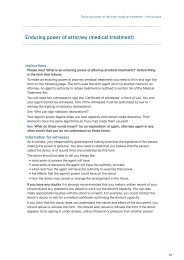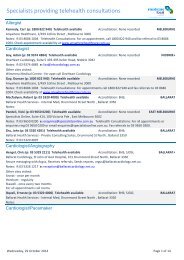Dr Louise du Plessis Paediatrician
Dr Louise du Plessis Paediatrician
Dr Louise du Plessis Paediatrician
You also want an ePaper? Increase the reach of your titles
YUMPU automatically turns print PDFs into web optimized ePapers that Google loves.
<strong>Dr</strong> <strong>Louise</strong> <strong>du</strong> <strong>Plessis</strong><strong>Paediatrician</strong>
Specific issues Diagnosis Appropriate urine specimens Management issues Infant < 3mo Imaging? Who? Which investigation? When? Why? AB prophylaxis? Prevention
UTI facts Common 3.6% of boys, 11% girls Recurrent recurrence rate in first year of life 12 – 30% Potentially severe 10% UTI in 1 st yr have bacteraemia 90% UTI in 1 st yr have pyelonephritis Potentially long term consequences 5% permanent renal damage ESRD in 1 in 6000 – 1 in 20 000
What is a UTI?Clinical features+positive urine culture of a single pathogenic organism
Clinical presentation Pyelonephritis Fever, loin pain, nausea, vomitingmore common, especially in < 2y old Cystitis Dysuria, frequency, incontinence, lower abdominal pain,haematuria offensive urine? parental report not predictive* Infants non-specific fever, lethargy, irritability, poor feeding, failure to thrive,vomiting, diarrhoea, jaundice* ADC 2003
Important practice points In the absence of another clear focus, a UTI is themost common cause of fever in young children UTI does not exclude other infections (e.g.meningitis) 2% of children have asymptomatic bactiuria Other infections do not exclude UTICheck urine in all febrile children
Confirming a UTIUrine specimenDipstick testMicroscopyCulture
Confirming a UTIUrine specimenDipstick test SPA – Supra-pubic asirate CSU – Catheter specimen urine MSU – Mid-stream urine CCU - Clean-catch urine BAG URINEMicroscopyCulture
Confirming a UTIUrine specimenDipstick testMicroscopy Bag urine specimens 50% false positives Cannot be used to diagnose a UTI Can be used to rule out a UTI, if collected welland processed quickly If UTI is a reasonable possibility, do not collectbag specimens NEVER send a bag for cultureA BAG urine = a BAD urinedilemmas with treatment and investigationmorbidity and cost implicationsCulture
Confirming a UTIUrine specimenDipstick testMicroscopyCulture SPA, CSU: for unwell infants or children who need tostart immediate Rx 100% specific to exclude UTI SPA up to 18mo/?2years CCU: specificity 90 – 97%, sensitivity approximating100% close to 100% success rate in obtaining within 5minutes of feed using the Perez reflex MSU: 3-4y onwardsProcess any urine specimen ASAP(E.coli doubles in an hour at room temperature)
Confirming a UTIUrine specimenLeukocyte esteraseRelated to degree of pyuriaNitritesDipstick testMicroscopyPro<strong>du</strong>ced from nitrates by bacteria, especially G-False negatives:EnterococcusShort time urine in bladderi.e. Pos nitrites usefulNeg nitrites not usefulOverall sensitivity of dipstick (leucocytesand nitrites +) only around 70%Better with high numbers of organismsCulture
Confirming a UTIUrine specimenDipstick unreliable in < 3mo oldA negative dipstick result does not excludea UTIDipstick testMicroscopyIf clinical suspicion of UTI high, send forculture regardless of dipstick resultAlways culture:< 3 mo or unwell lookingsuspected pyelonephritishistory of recurrent UTI’snot responding to Rxclinical Sx and dipstick do not correlateCulture
Confirming a UTIUrine specimenDipstick testMicroscopyCultureEnhanced Urinanalysis• Microscopy of uncentifuged specimen• WBC/mm 3 (pyuria > 10 WCC/mm 3 )• Gram stainSensitivity 95%Bacteria, but no WC’s:• Asymptomatic bactiuria (1 – 3%)• ColonisationWC’s, but no bacteria:• PyuriaNot uncommon with feverWC’s + bacteria, low squames = verylikely UTI
Confirming a UTIUrine specimenDipstick testChosen cut-off level of organisms forpositive culture Any pure growth from an SPA Pure growth from CSU, MSU, cleancatch: ≥10 5 per litre Pure growth of 10 4 per litre: ? early infection repeat cultureMicroscopyCulture
Upper tract involvement? Not uncommon, particularly in young children Mostly associated with fever More unwell than with lower tract infection Loin pain/tenderness in older children CRP, FBC do not correlate stronglyBigger potential for renal scarring
Acute management**NICE Guidelines (National Institute for Health and ClinicalExcellence, UK), 2007http://www.nice.org.uk/nicemedia/pdf/CG54quickrefguide.pdf < 3mo old, febrile, unwell 3mo - 3y >3y suspected pyelonephritis
3mo old, febrile, unwell refer: needs full paediatric assessment collect appropriate specimen (SPA, CSU) urgent MC+S(dipstick alone unreliable) start empirical antibiotics IV
3mo - 3y old High risk refer urgent urine MC+S start empirical AB’s if febrile Medium risk consider referral urgent MC+S, dipstick if urgent micro not available start AB’s if microscopy positive or nitrites positive ondipstick Low risk send MC+S start AB’s with positive culture
3y old Urine dipstick leuco’s +, nitrates + : start Rx leuco’s -, nitrates + : leuco’s +, nitrates - :evidence leuco’s -, nitrates - :start Rxsend MC+S, only Rx UTI ifunlikely UTI, do not Rx as UTI
Suspected pyelonephritis Consider referral Obtain blood tests, including culture Consider need for starting treatment IV (until afebrilefor 24 hours) Complete 10 days of treatment
What causes UTI?Intro<strong>du</strong>ction of pathogenic bacteriaMostly ascendingOccasionally haematogenous? Abnormal urine flow40% of children with UTI have renal tractabnormalities1. Vesico-ureteric reflux (VUR) 35%2. Renal scarring 12%3. PUJ or VUJ obstruction 4-6%
VUR Ureter normally entersobliquely through bladderwall. In VUR, ureter enters moreperpendicularlyImpairs one-way valve effect
VUR Facts Up to 10% of all children Inherited Lower grades (I – III) resolves with age 1/3 of children with 1 st UTI
Scars (Reflux nephropathy?) Permanent renal damage caused by “scars” in thekidney Pyelonephritis can leave scars Does VUR cause scars?
• Kidney infection because of reflux• Infections cause scars• Important to identify and monitorreflux• Prevent damage by:• fixing reflux (surgery)• preventing infections(prophylactic antibiotics)
Problems with “VUR UTI Scars” theory Many scars already present before UTI Even antenatally: “Antenatal hydronephrosis” VUR on its own (without UTI) not shown to bedangerous Upper tract UTI without VUR may cause renaldamage Many sibs of children with VUR have renal damagewithout apparent UTI.
Bottom line The link between VUR, UTI, Scars and ESRD remainsunclear Lower grades VUR Resolve without intervention Higher grade reflux will not be missed on USWhy follow/investigate lower grade VUR?
Imaging Renal/bladder Ultrasound (US) Micturating Cystourogram (MCU) DMSA Scan DTPA/MAG3 ScanDilatationRefluxScarsFunction
Renal/bladder UltrasoundDetects nearly 100% of obstruction 50% of reflux 20% of parenchymal abnormality
Renal/bladder Ultrasound* First UTI in infant < 6 mo of age/?All first UTI’sUS within 6 weeks Obstruction, abscess, obvious renal tract abnormalities,including higher grade reflux All children with atypical UTI’sUS <strong>du</strong>ring acute infection to identify structural abnormalities of the urinary tract* NICE Guidelines (National Institute for health and Clinical Excellence,UK), 2007
Micturating Cystourogram (MCU)Reserved for Young (
DMSA scan Children younger than 3y with atypical orrecurrent UTI 4 -6 mo post infection to identify renalparenchymal defects
Evidence: Mx of VUR Investigations and imagingNo evidence for better outcomes with invasive imagingNo increase in ESRD with less imaging SurgeryReserved for complicated cases(e.g. severe reflux and recurrent UTIs) Prophylactic antibioticsJury still out in uncomplicated lower grade VURAppropriate with recurrent UTI’s, high grade reflux
Evidence changing practice
Priorities Early diagnosis and appropriate treatment of UTIs Selective investigation and preventive measures inhigh risk children (high grade reflux and significantobstruction) Antenatal hydronephrosis an important risk factor >8mm on 34 w antenatal US US on D 7, earlier with marked dilatation or if bilateralDon’t forget to look for and treat constipation
Advice to patients/family Consider UTI when unwell Collect an appropriate urine specimen whenconcerned Seek prompt treatmentMost useful strategy to re<strong>du</strong>ce morbidity fromUTI’s and subsequent renal scarring is promptdiagnosis and appropriate treatment
Background Involuntary night voiding > 5yo Primary (75%) vs secondary (25%) Monosymptomatic nocturnal enuresis only Polysymptomatic daytime wetting (detrusor instability) or additional urinary symptoms also
Causes 50% have family history 1 parent = 44% chance 2 parents = 77% chance CX 13q (ENUR1), 12q (ENUR2), 8, 22 autosomal dominant
Multiple mechanisms Immature cortical inhibition Insufficient nocturnal ADH pro<strong>du</strong>ction =nocturnal polyuria Sleep dysfunction ‘deep sleepers’ OSA Psychological factors seldom of primaryimportance Organic causes uncommon, but need exclusion
What to exclude? Neuro neuro exam, no Ix unless concerns UTI MSU worthwhile as routine Obstructive consider renal U/S if older/unresponsive Diabetes should get this on history, also urine glucose consider blood sugar testing if concerns Constipation!
Further investigation? Only needed if polysymptomatic urinary flow assessment urine output assessment U/S for post-void resi<strong>du</strong>al volumeRefer
When to manage? Never < 5yo Minimal intervention < 7yo consider start charts Aim therapy at 7yo+ Urgent therapy >10yo
Management Motivation of the child Step 1: star charts better in younger kids Step 2: enuresis alarms (pad & bell, body) 75% success if used properly, 20-30% relapse takes several months, may need repeat efforts Over-learning: increasing fluids once child is dry withalarm Step 3: medications – non curative Other approaches Concurrent bladder training diary
Monosymptomatic meds Desmopressin (Minirin) most reliable, success proportional to bladder capacity oral form (tablets or S/L) safer than nasal spray* Tolterodine (anticholinergic) useful in monosymptomatic enuresis if added todesmopressin ** Imipramine (Tofranil – tricyclic antidepressant) relapse after cessation common anticholinergic/behavioural SFX, dangerous in OD* linked in evidence with hyponatraemic seizures, thus TGA recommends nasal form only when oralform not feasible** Austin PF, et al. Combination therapy with desmopressin and an anticholinergic medication fornonresponders to desmopressin for monosymptomatic nocturnal enuresis: a randomized,double-blind, placebo-controlled trial. Pediatrics 2008; 122: 1027-1032.
Monosymptomatic other Rx Fluid restriction not effective in trials advised in combination with desmopressin to avoidhyponatraemia Night time ‘lifting’ may help somewhat non-curative
Polysymptomatic Rx Oxybutynin (Ditropan) aims to help detrusor instability (urge incontinence) useful to increase bladder urine retention thus capacity Tolterodine (Detrol/Detrusitol) not on PBS Propiverine (Anticholinergic & Ca channel blocker) better than placebo at re<strong>du</strong>cing incontinence & voiding episodes/day* not available in Australia• Marschall-Kehrel, D. Treatment with Propiverine in Children Suffering from Nonneurogenic Overactive Bladder andUrinary Incontinence: Results of a Randomized Placebo-Controlled Pahse 3 Clinical Trial. European Urology 2009; 55(3): 729-738
Polysymptomatic Rx Regular voiding some evidence of effect from USA uses both a voiding regimen & relaxed voiding* aims to help dysfunctional voiding Increasing fluids** no evidence of effect used alone recommended by some in conjunction with other techniques* evidence conflicting regarding the efficacy of relaxed voiding & bladder training programs** This is not the same as ‘over-learning
Outcomes 15% spontaneously resolve per year A<strong>du</strong>lt incidence only 1%




